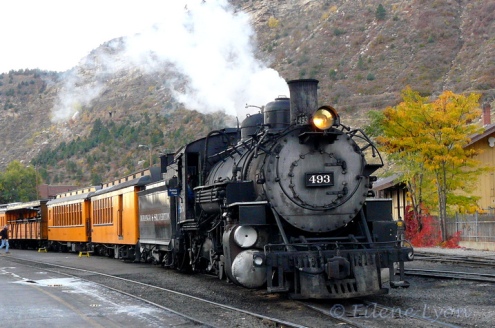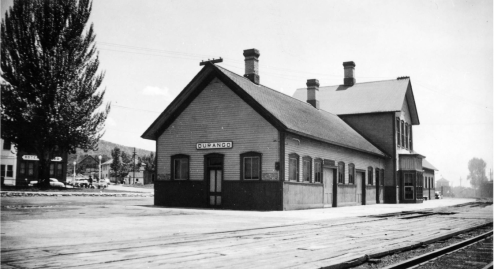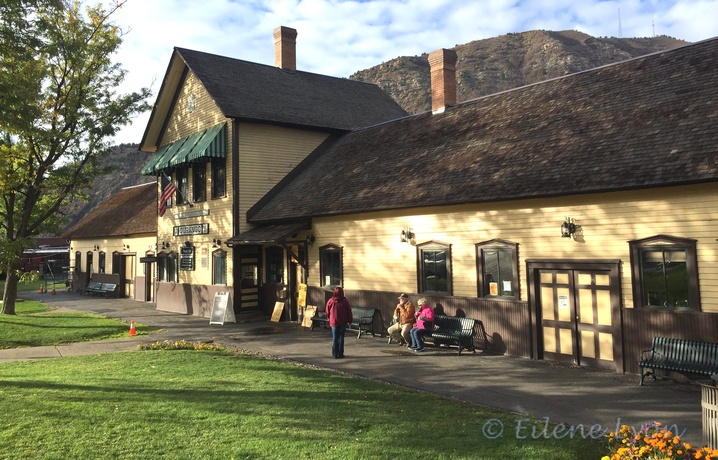By Eilene Lyon
With the encouragement of Anabel at The Glasgow Gallivanter and Brandi at Make the Journey Fun, I’ve decided to share bits of my Old West hometown. One project I’d like to undertake, perhaps as a book someday, is a study of Main Avenue buildings and the businesses they’ve housed over the past 140 years that Durango, Colorado, has been in existence.

The first building to profile is a no-brainer. Completed in January 1882, it is one of the oldest in town. That is a spectacular feat of longevity, because it is not built of brick or stone, but wood. And another claim to fame is that it has been in continuous operation for its original purpose through all these years, as a railroad depot. It first served the Denver & Rio Grande (the company that founded Durango) and now the Durango & Silverton Narrow Gauge.
Historic train stations invite visitors to conjure an age when steam locomotives offered the fastest transportation on the planet. Though uncomfortable by today’s standards, the passenger cars, riding on smooth metal rails, were luxurious compared to the rough, dusty rides provided by stage coaches, wagons, and buggies. In a matter of weeks, rather than months, a passenger could cross the continent. How modern!
Station platforms bustled with passengers decked out in their finest dresses and suits, all wearing bonnets, bowlers, top hats, and Stetsons. They gripped their carpetbags, valises, hatboxes, and umbrellas, with the latest edition of the news tucked under one arm. Steam and smoke billowed from the locomotive stacks, a whiff of sulfur emanating from the burning coal. The conductor shouted, “All aboard!” and the shrieking steam whistle threatened to burst eardrums.
The Durango depot’s survival is amazing when you realize that 1) it has no true foundation, and 2) there are coal-fired engines parked next to it. Just one wayward cinder… And more astonishing when you learn that the nearby roundhouse (where they store and maintain idling locomotives) burned to the ground in 1989. Still, the depot stands.

The address is 479 Main Avenue, but it used to have a second address in the days when it served two separate railroad lines. It is the only building in the 400 block of Main Avenue, originally called First Avenue. From the Sanborn maps, we can see that the street used to extend south from the station, but it no longer does.
Low-rent hotels and saloons in that block serviced the traveling salesmen who arrived on the train. Though the railroad’s principal business was carrying ore from San Juan Mountains mines, it has always carried passengers.

The depot’s interior uses have changed over the years. In the early days, the waiting room occupied the center, with a telegraph office to the south and a baggage room and express office on the north. The central portion has an upper floor and used to be a dwelling, but now serves as business office space.
I spoke with Jeff Ellingson, museum curator, for more information. (Museum entrance is free—I’ll take you there another time.) The clapboard siding, wainscoting, and roofing were replaced over the past five years. Though the exterior paint no longer contains lead, it retains the original color: yellow ocher with a luscious chocolate-brown trim.

Ellingson indicated that the north section of the depot held separate waiting areas for men and women, but I don’t know in what time period. Both ends now house gift shops and a coffee counter. The ticket office, waiting areas, and much-too-small restrooms fill the central section. The building is included in the Durango-Silverton Narrow Gauge Line Historic Landmark on the National Register.
Since it is October, and we’re discussing an old public building, we need to know more about its ghosts. Ellingson says the depot’s spirit denizens are completely benign and rarely encountered. They pull minor mischievous pranks. However, the upstairs offices had a resident cat in the early 2000s, appropriately named Cinders, that bristled at the entrance to the north attic and would not enter that portion of the building. Unless a huge, radioactive rodent occupied the premises, we’ll just go with the ectoplasm theory.1

Perusing old newspapers online turned up a number of depot mentions:
1888: After battling enormous snow drifts in mid-March on Conejos Pass, the train arrived at the Durango depot carrying Sheriff Stoddard of Rice County, Kansas. Stoddard was met at the station by local Sheriff Turner and Stoddard’s quarry: admired Durango resident and accused murderer, A.C. Meyers (also called Myers in the article). Meyers willingly gave himself up for extradition and trial, along with accused accomplice George West, whom they would pick up in Lyons, Kansas, on their way back east.2
1901: During a period of major labor unrest, Cole Lydon, superintendent 4th division of the Denver & Rio Grande, posted a notice at the depot ordering all yard workers to report immediately for duty or be considered terminated by the company.3
1903: A couple miles from the depot, the train heading for Denver the morning of March 16 hit a small boulder that had rolled off a nearby hill and wedged between a crossing plank and the rail. None of the 40 or 50 passengers were notably injured. The engine did not fare so well. “Old railroad men say they never saw a locomotive so badly used except in a head end collision at full speed.”4
1904: “The Durango depot needs a big arc light for the arrival of late trains when the roads are running behind schedule time. Darkness has enthralled several hundred passengers who have arrived over the past few weeks.”5
1905: A scathing article appeared when an entire Rio Grande Southern train tipped over causing an untold number of injuries. The writer, who waited at the depot with other worried people for the ambulances to arrive, blasted all the rail lines coming into Durango as being in “deplorable condition.” He also urged the firing of Superintendent Meldrum for ignoring the injured passengers in favor of the freight.6
1909: Bert O. Clark, a Black man working as the mail clerk on the Silverton line, suffered massive hemorrhaging due to consumption as his train was about to leave the depot on February 27. He soon passed away and the Durango Evening Herald printed a lengthy, laudatory obituary. A portion was republished in the historic Black newspaper, the Iowa State Bystander. His father was a well-known minister in the AME Church in Chicago. Mr. Clark resided at the home of Mrs. Washington at 828 Second Ave. and she tenderly cared for him in his dying days.7
1923: Sheriff Wagner of San Miguel County arrested Durango depot worker J.A. McKinley for stealing ore worth thousands of dollars. McKinley stated he had permission from the depot company to keep what he cleaned out of the cars after unloading. He immediately began replevin proceedings to retrieve the seized ore.8

1924: Durango pioneer Jeff Sease died of an apoplectic stroke at the depot on Christmas Eve as he waited to board a train to Cedar Hill, New Mexico.9 (Might he be one of the depot ghosts?)
One news story threw me for a loop. It said a tornado had picked up the entire depot and tossed it in the river! That is how I learned there is a place named Durango in Iowa.
Feature image: The east (street) side of the Durango depot. I think you’ll agree the landscaping has greatly improved in recent times. (E. Lyon 2021)

- Interview with DSNGRR museum curator Jeff Ellingson on October 14, 2021. ↩
- “Murder and Mystery” The Lyons Republican, April 5, 1888 p. 1, quoting the Rocky Mountain News of March 14, 1888 – Newspapers.com. ↩
- The Durango Democrat, November 9, 1901 p. 4 – Colorado Historic Newspapers Collection. ↩
- The Telluride Journal, March 19, 1903, p. 7 – Colorado Historic Newspapers Collection. ↩
- The Durango Wage Earner, August 18, 1904, p. 3 – Colorado Historic Newspapers Collection. ↩
- The Durango Democrat, September 28, 1905 p. 2 – Colorado Historic Newspapers Collection. ↩
- “Bert O. Clark” Iowa State Bystander, April 2, 1909 p. 1, quoting the Durango Evening Herald – Newspapers.com. ↩
- The Indicator (Pueblo), May 5, 1923 p. 2 – Colorado Historic Newspapers Collection. Replevin is a proceeding to provisionally return seized goods pending the outcome of an action to determine rightful ownership. ↩
- Daily Journal (Telluride), December 30, 1924, p. 1 – Colorado Historic Newspapers Collection. ↩

I cannot wait to read this tonight!!
LikeLiked by 1 person
Delightful!
LikeLiked by 1 person
Thank you!
LikeLike
Thanks for following that up, Eilene! I’ll come back to read fully later.
LikeLiked by 1 person
And now I have! Fascinating history, thanks – looking forward to more.
LikeLiked by 1 person
We’ll see what piques my interest next!
LikeLiked by 1 person
I like this depot and its history. I’m fascinated that it has no true foundation, which seems impossible to me. The ghosts seem to be benign which is a relief. I love the photo from the early 1920s. The clothes the women are wearing, while formal by today’s standards, make me wonder if those short skirts were seen as risqué by certain members of society.
LikeLiked by 1 person
Choosing just a few historic photos was difficult, but that one from 1923 had motion to it, and most of the others didn’t have any people at all, so it was a keeper. Apparently the building was just constructed right on the ground. When you look at it, the wood does go all the way to earth. I expect the railroad assumed it would burn down before the century’s end and be rebuilt in stone.
LikeLiked by 1 person
It was really fun to read about the Durango Depot, Eilene. You brought it all alive with your well-written narrative, fascinating vintage photos, and the news accounts from early times.
LikeLiked by 1 person
Thanks, Jet. I expect it will be a lot of fun for me to learn more history of my adopted hometown. I’m glad others can enjoy it, too.
LikeLiked by 1 person
Wonderful imagery of the early train travel. Is there still a passenger train that goes through Durango or just for cargo?
LikeLiked by 1 person
Very little cargo, if any! The train is a huge tourist attraction. It always has been, but become solely a tourist train about 1980.
LikeLiked by 1 person
This is awesome
LikeLiked by 1 person
Thank you, LA! Come out and visit. 🙂
LikeLiked by 1 person
I just might!💗
LikeLiked by 1 person
Just a little sampling of the rural life!
LikeLiked by 1 person
I loven old train depots! Yours appears to have had quite a checkered history among the people associated with it. I also think it’s important to preserve old buildings and their histories.
LikeLiked by 2 people
Yes, Durango wouldn’t be Durango without it’s historic buildings and the litany of businesses that occupied them. The builders, designers, owners, etc. all have tales to tell.
LikeLiked by 2 people
Those tales will make a great book, should you decide to go down that road.
LikeLiked by 1 person
Thanks, Liz. I hope to get some first-person tales from locals, too.
LikeLiked by 1 person
Even better!!
LikeLiked by 1 person
Wonderful history! How did that Meyers’ murder trial turn out?
LikeLiked by 1 person
That would be worth looking into. It involved horse theft. Clearly Meyers and West felt they would be exonerated. But I’m not so sure they were innocent, based on the news report at least.
LikeLike
Eilene, I really enjoyed reading your blog about the train station. I would be very interested in reading more about other historic buildings in Durango and could easily imagine a whole book with similar articles. Good job!
LikeLiked by 1 person
Thanks, Kate! I think it will be a fun project, and I plan to share some of my research here on the blog.
LikeLike
Eilene, there is certainly a need for more people to write about their personal perspective on local history. Good thing that Anabel encouraged you. I love all things to do with rail though not a train nerd, well, not yet.
LikeLiked by 1 person
Thank you, Suzanne. I love this area and know a bit, but still have much to learn, even after living here 36 years. The train made this town, and is still an integral part of it. I’ve ridden it a few times, once in 19th century costume: https://myricopia.com/2019/10/31/the-slide-years-costumes/
LikeLike
Love getting to hear about the history of your hometown, and I look forward to more! And of course I appreciated the ghost story. I bet Cinders would have some stories to tell.
LikeLiked by 1 person
It was probably a giant, radioactive dog. 😉
LikeLiked by 1 person
Thanks for the great history of the Durango Depot. I have ridden that train many times , and have photographed the building a few times. But I never knew all of this history. Awesome read. Thanks again.
LikeLiked by 1 person
Thanks for stopping by and commenting, Tim. I checked out some of your photographs from the train journey and they are excellent!
LikeLike
Thanks Eileen! Durango is certainly a cool little town. Thanks again. 🙂
LikeLiked by 1 person
Yes, it is. I love living here.😊
LikeLike
This is a fun read and I love how you transported us to another time and place. I am reaching for an excuse to visit.
LikeLiked by 1 person
No excuses needed!
LikeLiked by 1 person
They really don’t write em, make em or see em like this any more.
LikeLiked by 1 person
In the FB discussion on this, some locals were concerned there wasn’t a fire suppression system (someone said there is). And that the building should be lifted, moved and put back on a foundation with a basement. Apparently it was proposed back in 1992. I doubt we’ll see that happen. Journalism in those days sure produced some wild tales!
LikeLiked by 1 person
This was an interesting read Eilene and I’m going to pass it along to a friend who is very interested in trains. I’m sure he’ll savor reading about this treasure. I will look forward to the post about the museum next time.
LikeLiked by 1 person
Thanks, Linda. Our local train is quite a draw for train buffs from around the world.
LikeLiked by 1 person
John really enjoyed the post Eilene and I promised I would send him the follow-up on the museum. He is a train buff and belongs to a model train club where they build trains that they can actually ride on.
LikeLiked by 1 person
Thanks for passing it along, Linda. I’m not sure when the museum piece will come about.
LikeLiked by 1 person
Yes, he enjoyed it very much Eilene. OK, sounds good – when it happens, I will pass it along.
LikeLiked by 1 person